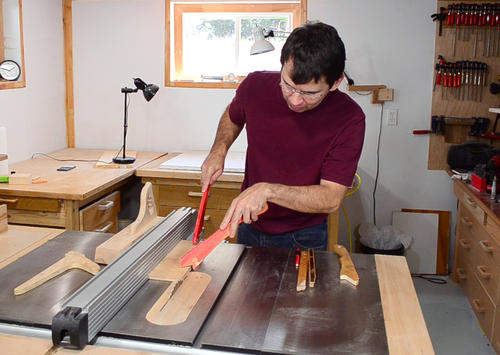
If you want to construct things out of wood, a table saw is one of the most useful and versatile tools that you can have in your workshop.
A table saw is going to be especially critical if most of the projects you make, center around furniture and home improvement projects.
If your project uses wood, then you’re more than likely going to need to run some of it through a table saw at some point. But using a table saw can be a frightening experience.
Many new woodworkers are tentative around table saws because they seem intimidating. While it’s true that people can lose fingers on a table saw, the hazard risk can be greatly minimized by showing respect and care while using the saw.
Simply understanding how a tool works, and purchasing a few table saw safety accessories, will go a long way in building your confidence.
Always practice general safety as a fundamental guiding principle while using the table saw.
Even if you’ve been using a table saw for years, you still might sometimes set up an awkward cut.
It’s always better to reconfigure your wood than it is to make a hasty and potentially unsafe cut. Don’t place your hands in an awkward position while cutting wood on a table saw, and don’t position your workpiece in a way that makes it unstable.
If it doesn’t feel right, don’t make the cut. There are more ways than one to make cuts, so reset the wood and your hands until everything feels stable and safe. There’s always time to find a safer table saw cutting method.
Before you make any cut, always plan where your hands and your body will be positioned.
You need to stay aware of your body, particularly your hands, throughout the entirety of your table saw cut. This should become second nature such that you are doing it every single time. You never want to get stuck with a wayward piece of wood halfway through a cut. You should always have a plan for safely guiding your piece of wood all the way through the table saw.
Pick the right blade for your table saw.
Although you have many choices for table saw blades, from a rough cutting 20 tooth blade to a fine cutting 60 tooth blade, you can safely use a multi-purpose combination cutting blade for most of your projects.
There generally aren’t many advantages to buying specialized crosscut blades. To set up your table saw for a cut, install the blade with the teeth facing you (if there’s an arrow on the blade, use it to help guide you.) You’ll attach the blade to the arbor using a washer and a nut. The insert plate goes around the blade assembly and sits flush with the table top of the saw.
Make sure to calibrate your rip fence.
A rip fence is used for cutting any long length of board that is longer than it is wide.
It’s important that whatever table saw you purchase comes equipped with a rip fence. Even the most inexpensive table saws should be equipped with them. Make sure to calibrate your rip fence and check that it’s perfectly square. You also want to make sure that the rip fence glides smoothly over the surface of your table.
Use your rip fence to make the cut.
To use your rip fence, you’ll slide it away from the board according to the size of the cut you need. You’ll want to make sure to raise (or lower) your table saw blade to cut just a mite higher than the height of the board. As soon as you have your fence set and your board in position, fire up the saw and push the board against the rip fence to start the cut.
Slowly feed the wood through the blade, making sure that the piece of wood remains in contact with the rip fence. Keep your eyes focused more on the fence (and not the blade), since it’s crucial that the wood stays in contact with the fence throughout the entire cut.
If your table saw comes with a push stick, use it to push the wood through as you make the cut. If it didn’t come with one, you can use a small piece of wood to use as a guide for your wood cuts. The most important thing is safety when you use the table saw.
You don’t want to use your hands to push the piece of wood through the table saw. Keeping your fingers out of the way of the spinning blade is a safety precaution you should always take.
Install a riving knife or splitters to make table saw cutting even safer.
Most table saw injuries are caused by when wood gets awkwardly shot out from the table saw, a phenomenon known as kickback. Kickback happens when the wood gets twisted or torqued as it makes it way through the cut.
The rear of the blade can catch the wood and throw it off the table at high speed. Since the blade is spinning at thousands of revolutions per minute, a piece of wood that gets caught and flung backward by the blade can fire at you like a missile.
To help mitigate against kickback, try installing a riving knife behind your cutting blade. A riving knife is simply a metal guard for the blade that helps prevent the wood from binding with the rear of the cutting blade.
Another option is to use splitters, which puts a barrier between the wood and the rear of the cutting blade. This keeps the wood separated as you finalize your cut. As a general rule, you want to be out of the line of fire if kickback does occur. And the best way to keep yourself safe is to stand off to the side while making your cut.